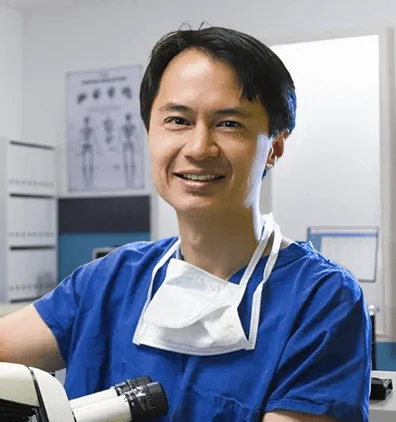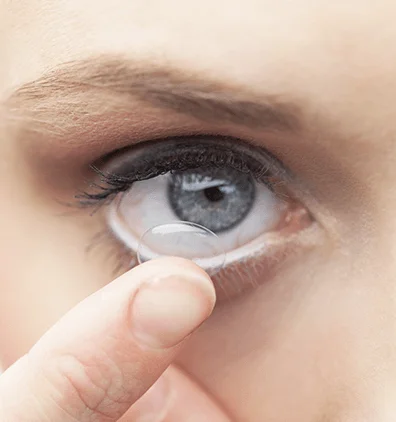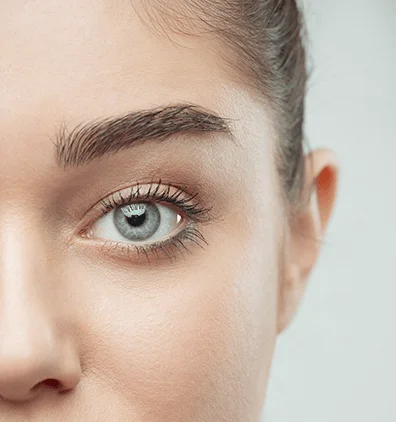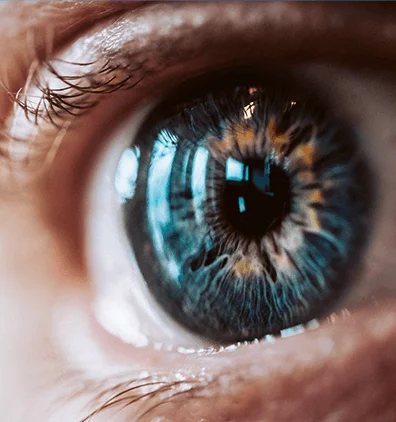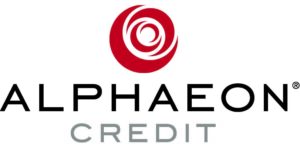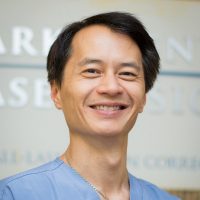PRK
An Explanation of Why You Should get LASEK — NOT PRK!

PRK is the oldest first form of laser vision correction procedure, invented & patented by Drs Steven Trokel & Francis L’Esperance 30 years ago, who are the two surgeons who certified Dr. Chynn on their respective lasers (VISX & Summit) 25 years ago, at the very beginning of laser vision correction.
PRK is called a “surface ablation” because the laser is applied to the cornea surface, as opposed to LASIK, which requires a cut to lift up a flap of tissue, which is lifted up & the laser applied to the underlying “bed”.
PRK and all non-incisional procedures including LASEK and epiLASEK are inherently safer than LASIK because the cutting step, which is by far the most dangerous step, is eliminated.
PRK never became popular because it requires scraping off the skin of the eye on top of the cornea, which is traumatic so causes significant postoperative inflammation, pain, prolonged recovery, pain and sometimes even scarring. Dr. Chynn performed his last PRK in 1999. He now performs LASEK on every case that some other surgeon might say you need a PRK for, which means in his hands you will have much less pain, a quicker recovery, and much less chance of scarring than if you had gotten PRK!
When they can’t perform LASIK (e.g., when the patient has thin corneas, a high prescription, large pupils or dry eyes) the less advanced surgeons recommend PRK — but the most advanced surgeons now perform LASEK. This was invented at Harvard by Dr. Chynn with Dr. Juan Carlos Abbad & Dr. Jon Talamo, with whom Dr. Chynn published a paper. In LASEK alcohol is used to delaminate or gently separate the epithelium from the cornea, allowing it to be removed atraumatically, thereby preventing inflammation, pain, delayed healing and haze or scarring. Why get PRK by some LASIK surgeon, when you can get an Advanced PRK = LASEK by the surgeon who helped invent that procedure–Dr. Chynn?
If a doctor says you can’t get LASIK & recommends PRK, understand that really means you can get an older non-cutting procedure that is painful and takes forever to recover (PRK), or an “advanced surface ablation” that has NO pain and has a fast recovery (LASEK). PRK patients are in pain for a week, and don’t see well for 2-3 weeks. There’s no pain after LASEK, & patients see great within a week! Dr. Chynn is the only eye surgeon in the US who specializes in LASEK, & Park Avenue LASEK is the only center with LASEK in the name. That’s why we’ve performed more LASEKs than any other center or surgeon in the US, and more than every other eye surgeon in New York City-combined!
We had a Navy SEAL come in recently for an enhancement years after his original PRK by another surgeon. Military Special Forces are not allowed to get LASIK, because for the rest of their life the LASIK flap can get torn off by even minor trauma. After his LASEK enhancement he told Dr. Chynn, “I can’t believe I had no pain whatsoever after my LASEK.” Dr. Chynn said, “We told you it would be painless.” The SEAL replied, “Yes, but after my PRK I was curled up lying in a fetal position for a week despite taking narcotics, and I went to a LASIK surgeon who said your LASEK was nothing more than a glorified PRK. That’s wrong, LASEK is much more advanced than PRK.
If this were 1999, it would be reasonable to get or perform a PRK. Now it’s an outdated procedure. Dr. Chynn has performed over 1,000 PRKs, 10,000 LASIKs, 15,000 LASEKs 5,000 epi-LASEKs, 1,000 Pneumo-LASEKs (which he invented). If the experience of your surgeon matters to you—and it should—it would make no sense to get a PRK anywhere within 200 miles of Park Avenue LASEK, or to get a LASEK in NYC by anyone other than Dr. Chynn.
Comparison Table: PRK vs. LASEK
| Feature | PRK | LASEK |
|---|---|---|
| Procedure | Mechanical scrapes off the skin covering the cornea with a blunt blade, or sandpapering off with an electric toothbrush device (Amoils brush), which causes inflammation, pain and sometimes scarring. | ✅ Uses an alcohol solution to gently lift the epithelium, reshaping the cornea with minimal trauma. |
| Post-Operative Pain | Painful; patients need heavy-duty anti-pain prescription medications to tolerate the 1-2 weeks of recovery. | ✅ Painless; patients experience minimal discomfort due to clean, smooth removal of the corneal epithelium (using an alcohol solution). |
| Recovery Time | Long recovery; vision takes 2-3 weeks to stabilize; healing is prolonged due to trauma to the corneal surface. | ✅ Faster recovery with most patients seeing well within a week. |
| Risk of Scarring | Higher risk of scarring or haze due to the scraping process, especially in cases of high prescriptions (this is why many surgeons refuse to perform PRK over a -7 prescription). | ✅ Zero risk of scarring or haze formation (if the patient is compliant and takes their steroid drops after surgery). |
| Corneal Integrity | 🔵 Unlike LASIK or SMILE, it is non-cutting so the cornea is not weakened, so is acceptable for people who engage in boxing, martial arts, or extreme sports, or military Special Forces. | 🔵 Unlike LASIK or SMILE, it is non-cutting so the cornea is not weakened, so is acceptable for people who engage in boxing, martial arts, or extreme sports, or military Special Forces. |
| Ideal For | Often recommended when LASIK is not an option, but is basically a painful LASEK that takes forever to heal. | ✅ Suitable for patients with thin corneas, high prescriptions, dry eyes, or active lifestyles. |
| Long-Term Outcomes | Higher chance of poor vision from scarring compared to LASEK, so is about equally safe compared to LASIK or SMILE. | ✅ Better safety than LASIK (if you get poked in the eye years after LASIK, the flap can get torn off and you won’t ever see well). |
Our Videos

#1 Rated
LASEK, LASIK, PRK, SMILE Eye
Surgery Center in NYC
#1 Rated LASEK, LASIK, PRK, SMILE Eye Surgery Center in NYC
(212) 741-8628

Get Directions to Park Avenue LASEK
102 E 25th St, New York, NY 10010

